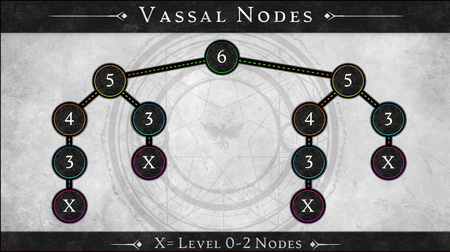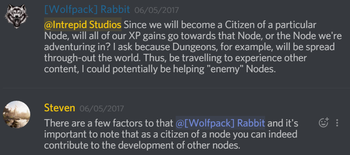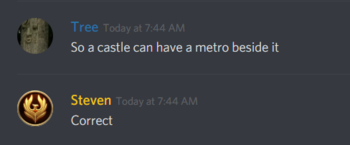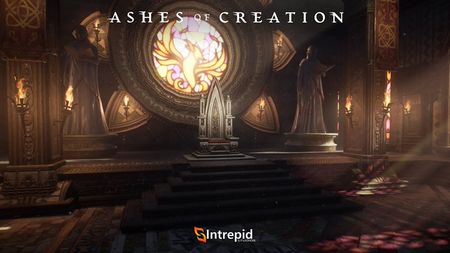Einflussbereich

Every Node is given purview over a predefined geographic area called a Zone of Influence (ZoI). No matter where you go in the world, whether you’re questing, gathering, or raiding, you’ll be helping determine which nodes will develop, and what Zones of Influence will expand. Any area that a Node controls is considered its Zone of Influence, including Vassal Nodes, and all Vassal Nodes exist within the Zone of Influence of their Parent Node.[2] – Margaret Krohn
Every node is given purview over a predefined geographic area called a Einflussbereich (ZOI). Player activity within the ZOI is weighted and counted toward a particular node’s advancement.[1]
The main thing that differentiates us from other MMOs is that we have a living, breathing, reactive world... Our world is separated into zones, which are then separated into what we call nodes. Nodes are sort of invisible zones of influence that listen to everything that a player does; so as players gain experience from killing things, gain experience from doing quests, gain experience through crafting things, the node is also gaining that experience. Once a node gains enough experience it levels up and then starts to attract NPCs to it .[3] – Jeffrey Bard
- By undertaking familiar activities, such as questing, gathering and raiding, players have agency in determining which nodes in the world will develop.[4]
Each Node can form into towns, but are limited by their neighbors. The Nodes have different levels of advancement. There can only be so many of each level. Think of this as advanced settlements needing more elbow room. Nodes encompass more land as they grow and will require more effort to be sustained. This system is a main driver for change in the world because it creates scarcity. As Nodes advance in stages of growth they will lock out neighboring Nodes from progressing, and will absorb their zones of influence.[1]
- Zones of influence connect fully across the world without any gaps.[5]
There is not a space where you will move in to do something and no node will get that experience.[5] – Steven Sharif
- Unterreich-Nodes and nodes directly above them are considered adjacent but do not exist in the same ZOI.[6][7][8]
- Up to one fifth of the world will be encompassed within the ZOI of a Metropole. The many vassal nodes within a ZOI's "border" could end up looking like a country or nation.[9]
Entwicklung der Node
Alle Aktivitäten (Aufträge, Sammeln, Schlachtzüge, etc.) welche von Bürgern sowie allen anderen Spielern innerhalb des Einflussbereichs einer Node ausgeführt werden, tragen zum Wachstum (Fortschritt) dieser speziellen Node bei.[10][11]
Durch das Wachstum einer Node werden einerseits deren einzigartigen Inhalte freigeschaltet, andererseits wird der Fortschritt der umliegenden Nodes auf die nächste Stufe blockiert.[12]
- Nodes steigen schnell auf die erste Stufe auf. Dadurch entstehen die ersten NPC-Dienstleistungen, beispielsweise der Verkauf oder die Aufbewahrung von items.[13]
- Je fortgeschritttener die Node ist, desto größer ist ihr ZOI.[14]
- Weniger weit fortgeschrittene Nodes (auch Vasallen-Nodes genannt), welche im Einflussbereich einer höherstufigen Node liegen, können weiterhin Erfahrung sammeln, jedoch müssen sie stets mindestens eine Stufe unter der ihrer übergeordneten Node bleiben.[15]
- Das Vasallen-System tritt erst ab Node-Stufe 3 (Dorf) in Effekt, jedoch blockieren Nodes bereits ab Node-Stufe 1 (Expedition) das Wachstum ihrer direkten Nachbarn.[16][17]
- Der Algorithmus zur Gebietserweiterung berücksichtigt nahegelegene Küsten, benachbarte Nodes, und die am häufigsten Besuchten Orte von Spielern innerhalb der letzten Woche, bzw. des letzten Monats.[18]
- Aufgrund der Art und Weise, wie dieser Algorithmus den neuen Einflussbereich während des Aufstiegs berechnet, kann es vorkommen, dass zwei Nodes mit der gleichen Node-Stufe nah beieinander liegen.[19]
Die Art und Weise, wie der Algorithmus die Gebiete erweitert, berücksichtigt einige Dinge: Erstens berücksichtigt er die Küste, beispielsweise wo die nächstgelegene Küste ist. Zweitens berücksichtigt es die benachbarten Modepunkte, sodass es diese Nodepunkte übernehmen und im Wesentlichen zu Vasallen machen kann. Wichtiger ist jedoch im Wesentlichen die anfängliche Bevölkerung, die darauf basiert, wie die Spieler ihre Rassen auswählen. Da wir neun verschiedene Rassen und vier verschiedene Startpunkte haben, die sich verzweigen, bestimmt die Bevölkerungsdichte jedes Servers im Wesentlichen die ersten paar Knoten, die stark bevölkert sind, und dieser anfängliche Samen bestimmt dann die Knotenstruktur, wenn er landeinwärts wandert das in die Welt im Wesentlichen; und basierend auf der Leistung und den Erfolgen verschiedener Belagerungen wird bestimmt, welche Node, die von den vorherigen anfänglichen Weiterentwicklungen ausgeschlossen wurden, welche Node jetzt für weitere Fortschritte verfügbar sind. Ich glaube also wirklich, dass bei so vielen Variablen, die in der Gleichung dafür vorhanden sind, wie Nodes voranschreiten und bestehen bleiben, die Wahrscheinlichkeit umso höher ist, dass es zu einer erheblichen Abweichung im Weltfortschritt kommt, je mehr Variablen man hat.[18] – Steven Sharif
Normalerweise verhindert der Algorithmus, der auf die territoriale Erweiterung der Node angewendet wird, dass wichtige Knoten nahe beieinander liegen Es gibt bestimmte Anforderungen, die verfügbar sein müssen, um Nodevasallenübernahmen zu erfüllen. Und es ist möglich, dass zwei Nodes sich niemals gegenseitig als Vasallen übernehmen und am Ende nahe beieinander liegen und ihre Territorien in entgegengesetzte Richtungen umspannen: Die Sache mit der Geschichte zweier Städte.[19] – Steven Sharif
- Vasallen-Nodes geben überschüssige Erfahrungspunkte erst dann an ihre übergeordnete Node weiter, wenn sie ihre Level-Grenze erreicht haben..[15]
- Die Möglichkeiten, für eine Node Erfahrungspunkte zu sammeln, sind für alle Arten von Nodes gleich.[21]
- Um Manipulation zu vermeiden, ist die exakte Anzahl an hinzugefügten Erfahrungspunkten für die Node durch das Erhalten von Gegenstände oder dem Töten von Gegnern nicht bekannt.[22]
Verschiedene Leute investieren unterschiedliche Ressourcen in die Weiterentwicklung von Nodes, und es wäre ein wenig „spielerisch“, wenn man genau wissen könnte, was zu diesem Zeitpunkt notwendig ist, denn das würde die Leute von der Teilnahme abhalten.[22] – Steven Sharif
Verschiedene Animationen und visuelle Effekte innerhalb der Grundfläche einer Node leiten den Beginn des ihres Aufstiegs ein.[23][10]
- Spieler, die sich zu diesem Zeitpunkt innerhalb der Node befinden, werden zu einem sicheren Ort teleportiert (beispielsweise einem Spawn-Punkt).[23][24]
- Um die Node herum spawnen Materialien, welche von systemgesteuerten Karawanen in die Node transportiert werden. Diese Karawanen können nicht angegriffen werden.[23]
- NPCs beginnen mit den Bauarbeiten.[23]
- Spieler, welche sich außerhalb der Node befinden, können die stufenweise visuelle Transformation der Node beobachten.[23]
Das Entwicklungsgebiet eines Nodepunktes ist der Ort, an dem die Zivilisation erscheint, wenn der Knotenpunkt voranschreitet. Mit zunehmender Nodestufe werden im Entwicklungsbereich verschiedene Gebäude, NPCs und Dienste verfügbar. Je höher die Nodestufe, desto komplexer und bevölkerter wird das Entwicklungsgebiet. Entwicklungsgebiete variieren auch je nach Knotentyp – wirtschaftlich, militärisch, wissenschaftlich oder göttlich.[10] – Margaret Krohn
Vasallen-Nodes

This vassal mode structure tells you what it looks like for a sovereign at a level six metropolis stage; and what it can control at a maximum vassal network is two level five nodes, of which a level five node can control one level four and one level three as direct vassals; and then the four can control a three; and every three can control a one or a two. Now if the three gets removed through siege, the one or the two is removed as well. So that's an important distinction between the three's vassals, which technically isn't really a vassal relationship because there's no citizenships possible. Those vassals don't exist between three and X, but they do exist between four and three, five and four, and six and five. And what this also allows is that because there are 85 nodes that are within the world, we have a buffer zone of about 20 nodes that lives in a max server state. So if you had maximum five metropolises form in a world, you will have a number about 20 nodes that can live alongside those metropolis networks; and when or if a metropolis falls, that extra cushion of nodes around the five metropolis structures allows for the map to be redistricted in a way that is unique. It doesn't mean that one of the fives is just going to pick up where the last six left off and form the same exact metropolis structure. From a territory perspective it has ancillary nodes to play with and expand towards that redistricts the map, so that if a metropolis falls there's a significant difference in the layout of the world and the layout of these almost nation-like territories.[25] – Steven Sharif
Village (stage 3) or higher nodes enslave nearby nodes, converting them into vassal nodes.[2][17]
- A Metropole (Stufe 6) can control up to two Großstadt (Stufe 5) nodes. A Großstadt (Stufe 5) can control one Stadt (Stufe 4) and one Dorf (Stufe 3) node. A Dorf (Stufe 3) can control an Feldlager (Stufe 2) or an Expedition (Stufe 1). If the Dorf (Stufe 3) gets destroyed through a siege, its dependant Feldlager (Stufe 2) and Expedition (Stufe 1) nodes are also destroyed.[25]
- There is a layer of intricacy between how the neighboring nodes advance and what potential parent structure they have in the vassalship tree.[26] – Steven Sharif
- Vassal nodes gain benefits from their regent node (also referred to as sovereign node or parent node) even if the node type of the parent is different to the vassal.[27][28]
- It is not a bad thing to be vasseled, it is a good thing to be vasseled. It brings many benefits from the Sovereign, which is the ultimate parent of that vassal network down to the vassal node itself; and it allows that vassal node to even live outside of its normal mechanics. You get to adopt some of the benefits that the node type of your sovereign is, even if your node type as a vassal node isn't the same.[28] – Steven Sharif
- Regent nodes collect taxes from their vassal nodes. These taxes cannot be taken by the mayor or other players.[30]
- Vassal nodes must remain at least one node stage below their parent node.[2]
- Neighboring/Adjacent nodes from Expedition (Stufe 1) upward block the growth of their immediate neighbors. This was intended to be tested in Alpha-1.[16][17]
- Vassal nodes first apply any experience earned to their own deficit (see Atrophie des Knotenpunkts). It then applies excess experience earned to its parent node.[10]
- If the parent node advances, the vassal is once again able to advance.[2]
- Vassal nodes give excess experience to their parent node and may have their own vassals; so long as they fall within the parent node’s zone of influence.[30][2]
- If a node is capped and is both a vassal and has its own vassals, any experience earned from itself or its Vassals is first applied to its own deficit. Experience beyond that is then sent to its parent node.[10]
- When the vassal reaches its cap it overflows experience up to the parent; and so it can be very good early on for parents to get vassal nodes that are very productive- that have a lot of traffic.[30] – Steven Sharif
- Vassals are subject to the government, alliances, wars, taxes, and trade of their parent node, and are able to receive federal aid from them.[2]
- Vassal nodes cannot declare war on their parent node or any of their vassals.[2]
- Citizens of vassals are bound by the diplomatic states of the parent node.[2]
- If a Node is a Vassal Node and is capped from advancing further, it first applies any experience earned to its own deficit (see Node Atrophy section), and then applies excess experience earned to its Parent Node. If the Parent Node advances and the Vassal is able to grow, it becomes uncapped. If a Node is capped and is both a Vassal and has its own Vassals, any experience earned from itself or its Vassals is first applied to their own deficit. Any experience beyond that is then sent to its Parent Node.[10] – Margaret Krohn
Zonen und Entwicklung
Dungeon, Schlachtzüge, Weltbosse, Mobs, Aufträge, Events, Ressorcen, Storys und andere Inhalte innerhalb der ZOI einer Node haben eine unterschiedliche Level-Reihe; wird aber mit det Weiterentwicklung dieser Node und seinem rassischen Einfluss skalieren.[31][32][2]
- Teile der Spawn-Tabellen (für Mobs und Ressourcen) sind statisch und andere Teile sind dynamisch und passen sich der Knotenentwicklung an. [33]
- Wir haben keine reine Level-25-Zone. Stattdessen könnte es in dieser Zone einige Kreaturen der Stufe 10 in der Nähe der Straße, einige Kreaturen der Stufe 20 tief im Wald und einige Kreaturen der Stufe 30 oben auf dem Berg geben. Diese Verhältnisse ändern sich abhängig von der Node, die euch informieren, und werden im Allgemeinen gefährlicher, wenn die Node wächst. Diese ganze Zivilisation zieht die Aufmerksamkeit von Dingen auf sich, die nicht sein sollten. Dies bedeutet keineswegs, dass Wildnisgebiete sicher sind. Einige mögen sicherer sein, aber alle bergen Gefahren, vor denen selbst der erfahrenste Reisende auf der Hut sein muss.[34] – Steven Sharif
Unterreich-Nodes
Unterreich-Nodes and nodes directly above them are considered adjacent but do not exist in the same ZOI.[6][7][8]
- There will be "bleed over" between underrealm nodes and surface nodes in terms of influence and interaction.[7]
- There may be visual cues above ground that indicate influence from underrealm nodes in that area.[7]
That might be a little bit of a departure from our design in the past. I know originally like two-plus years ago we were discussing how those would be independent of each other, but I think as we further defined the layout of the world map itself it made more sense for those to have some interaction and influence that's combined.[7] – Steven Sharif
- Caravan routes will go underground.[35]
- Node-Belagerungen occur in the usual manner.[36]
- There will be underrealm Metropolen.[37]
Castle regions
Gildenschlösser influence a castle region around them.[38]
- A castle's region is 1/5th the game world.[39]
- Castle regions, Economic regions, and Node ZOI (Zones of Influence) can overlap.[40][41]
- A castle could have a metropolis beside it.[42]
- Castle region boundaries are static.[40]
- Guild castles impose a tax on all revenue for the nodes within its region.[43][44]
Größe der Welt
1,200 km2 (square kilometers) is the expected total world size of Verra at launch, including land (480 km2) and water/ocean (750 km2), but excluding the size of the Unterreich.[45]
- This has increased from the previously stated total size of 480 km2 including land and water/ocean[46][47][48]; but excluding an additional ~100 km2 of Unterreich.[49]
- The Underrealm did not increase "too much" in size.[50]
- The reason given for expanding the map size was to better accommodate Zur See content and to reduce the overall content density in the world.[45]
- The purpose of it becoming bigger is as I said to make sure that density isn't overwhelming: that it isn't everywhere I look there is immediately something. I have no opportunity to see areas of the world that are expansive and are just wanderlust adventure feeling. Everything was sitting on top of you, POIs and nodes and houses and everything. It was like an urban area everywhere. But we wanted to expand that because a large portion of the game is a sandbox element; it's coupled with a lot of curated content but it's that sandbox element.[45] – Steven Sharif
- The shape of the continents has also changed and two new large islands have been introduced.[45]
Siehe auch
Einzelnachweise
- ↑ 1.0 1.1 1.2 Node series part I
- ↑ 2.0 2.1 2.2 2.3 2.4 2.5 2.6 2.7 2.8 Blog - Know Your Nodes - The Basics.
- ↑ Interview, 2018-04-20 (7:22).
- ↑ Ashes of Creation FAQ.
- ↑ 5.0 5.1 Liveübertragung, 2018-07-09 (39:32).
- ↑ 6.0 6.1 Liveübertragung, 2019-03-29 (58:14).
- ↑ 7.0 7.1 7.2 7.3 7.4 Liveübertragung, 2019-03-29 (29:17).
- ↑ 8.0 8.1 Liveübertragung, 2017-05-05 (37:52).
- ↑ Interview, 2018-05-11 (55:16).
- ↑ 10.0 10.1 10.2 10.3 10.4 10.5 Blog - Know Your Nodes - Advance and Destroy.
- ↑ A reactive world - Nodes.
- ↑ Video, 2017-04-20 (0:02).
- ↑

- ↑ Node series part II – the Metropolis.
- ↑ 15.0 15.1 Liveübertragung, 2017-10-16 (50:20).
- ↑ 16.0 16.1

- ↑ 17.0 17.1 17.2

- ↑ 18.0 18.1 Interview, 2020-07-18 (10:04).
- ↑ 19.0 19.1 Interview, 2020-07-08 (1:00:15).
- ↑

- ↑ Liveübertragung, 2021-09-24 (1:21:23).
- ↑ 22.0 22.1 Liveübertragung, 2017-05-26 (28:16).
- ↑ 23.0 23.1 23.2 23.3 23.4 Liveübertragung, 2022-10-14 (55:13).
- ↑ Liveübertragung, 2017-11-17 (55:27).
- ↑ 25.0 25.1 25.2 Liveübertragung, 2022-08-26 (1:07:34).
- ↑

- ↑ Liveübertragung, 2023-08-31 (52:56).
- ↑ 28.0 28.1 Liveübertragung, 2022-08-26 (1:04:35).
- ↑

- ↑ 30.0 30.1 30.2 Liveübertragung, 2022-08-26 (1:10:16).
- ↑ Interview, 2020-07-19 (19:35).
- ↑ Liveübertragung, 2017-05-15 (30:53).
- ↑ Liveübertragung, 2022-08-26 (1:28:50).
- ↑ Interview: Ashes of Creation on Building Their Virtual World, 2017-04-13.
- ↑ Liveübertragung, 2017-05-26 (31:44).
- ↑ Liveübertragung, 2017-05-26 (42:45).
- ↑ Liveübertragung, 2017-05-24 (31:39).
- ↑

- ↑

- ↑ 40.0 40.1

- ↑

- ↑

- ↑ Liveübertragung, 2021-04-30 (1:01:10).
- ↑

- ↑ 45.0 45.1 45.2 45.3 Liveübertragung, 2022-08-26 (46:52).
- ↑ Liveübertragung, 2020-01-30 (1:18:12).
- ↑

- ↑

- ↑ Interview, 2018-08-17 (10:43).
- ↑ Liveübertragung, 2023-04-07 (22:48).
